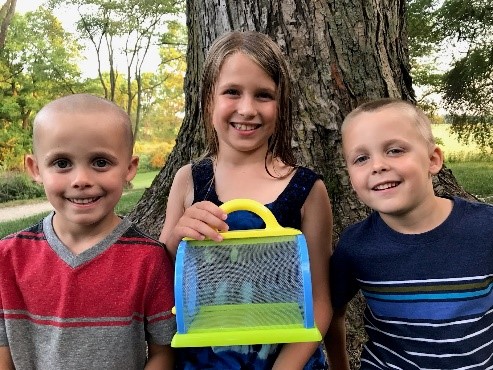My grandchildren’s little science project has turned into a profound lesson for me. In this little plastic habitat, two caterpillars who were plucked from a milkweed leaf near their house have spun a chrysalis. Within 10 days these two who began as striped beings with fat bodies who could only crawl from leaf to leaf will emerge as Monarch Butterflies with wings and the ability to take flight. In that 10 days they will completely dissolve their past caterpillar essences, grow wings and emerge in a new form, a bit moist, with tender wings – but with the ability to fly.
I know what you are thinking. Yes, the metaphor of caterpillar to butterfly is a very overused metaphor for transformation, But perhaps it is used so often, not because it is cliché, but because of the profundity of it.
The transformation process occurring inside the spun bright jade chrysalis is where true magic happens. To those observing, it appears that not much is happening. What seems to be resting, to be motionless, to be walled off from the world is none of that. On the inside the old caterpillar body dies, turns into a liquid and prepares to remerge as a butterfly. The caterpillar body is literally dissolved, digesting itself from the inside out. After three to four days, this rich fluid begins to regenerate into a new form using “imaginal” cells – that form wings, a body, legs and a mouth. Just because it is not visible, does not mean it is not happening. For this transformation, as with all others, begins on the inside.
What is true for the caterpillar is true for us human beings as well. For when “all” seems lost, a new “all” can be found. We can cocoon ourselves, discard the old and shape the new. This is exactly why I find hope for the turbulent times that we face now. For free of the constraints of the past, with conventions shattered, we can reimagine, reformulate, and re-create our world.
We are especially prone to this dramatic change when there has been a sharp inflection point and breaking from the past. It most often happens with a rapid change or loss – of a job, of a loved one, of innocence. It can also happen in those transitory times- from college to work, from work to retirement, from single to married, from childless to parents.
When faced with these transitions, we respond in different ways. Some of us will be resentful, angry and bitter over the loss. Others will be blind to the inflection point before them and will rush to blindly settle into some new form of status quo – not chosen, not ideal, but comfortable settled into a new “rut”. Others will recognize this transitory threshold and the potential it holds. They will understand that the current time and situation are a quickening, a Chism, an opportunity to take what is broken apart and to reassemble life’s parts and pieces into a new whole, a better whole, a stronger hole.
Most of the time the crises that create enough turbulence to shake us out of our complacency and push us into new ways of being are more singular in nature. We receive a health diagnosis that demands of us a big change. We are fired from the job that we didn’t like much anyway. A competitor eats our lunch and we have to redesign our product or service swiftly to stay alive. Our company is swallowed up in an acquisition and we must reinvent ourselves or be declared redundant.
The turbulence of 2020 has the hallmarks of upsetting the normal order of just about everything – our health, our health care system, our jobs, the economy, our beliefs and our social systems. Daunting without doubt. Yet ripe for profound positive change – at a personal level, at an organizational level and at a social level.
And so, in the midst of all that we are faced with now, we are also faced with a choice to make. Are we going to make something of this transitory time and be intentional about how to pass through it? Are we willing to take the brokenness and rebuild into new and better? Or will we choose to retreat into longing for the past or merely adjust to whatever comes our way?
For those of us that have the desire, the will and the courage to use this time to build a better future, I encourage you to start with these five provocative questions. These questions can work on a personal level, a team level or an organizational level.
- What is known know that was not able to be seen before?
- What are we choosing to leave behind?
- What do we want to carry forward?
- What do is our biggest and brightest vision for the future?
- What is the next step?
This series of questions works for individuals. It works for teams. It works for organizations. And it can work for communities or nations as well. Without doubt, the process to wrestle with the questions and to formulate answers gets messier the more people involved. But messy does not equate to impossible not does it imply not worth doing. In fact, it is the treasured outcome from turbulent times.
In my next post, I’ll walk you through each of the questions. I’ll describe why each one is important and ways you might do this work with your team, your department, your organization, your family or yourself.
Until then, begin to give some thought to what you would like to see emerge as the old dissolves and the new emerges.
I’ll end with a quote from Maya Angelou…
“We delight in the beauty of the butterfly, but rarely admit the changes it has gone through to achieve that beauty.”





